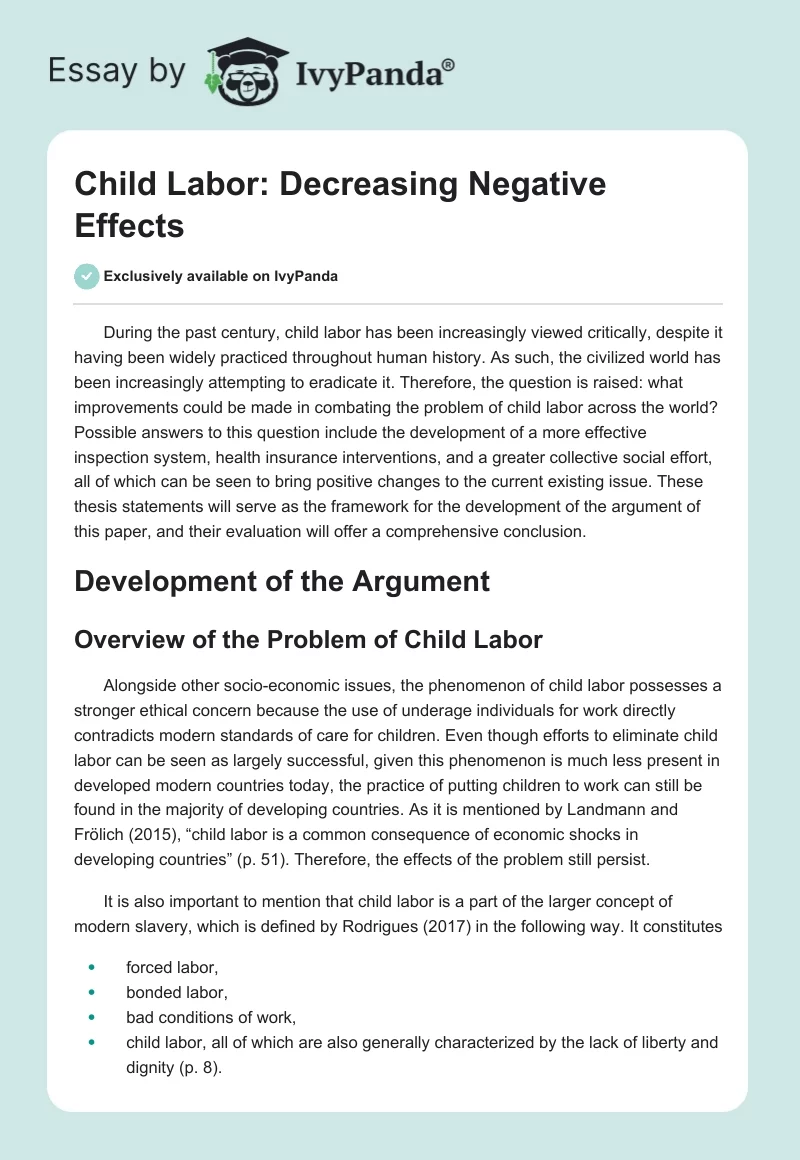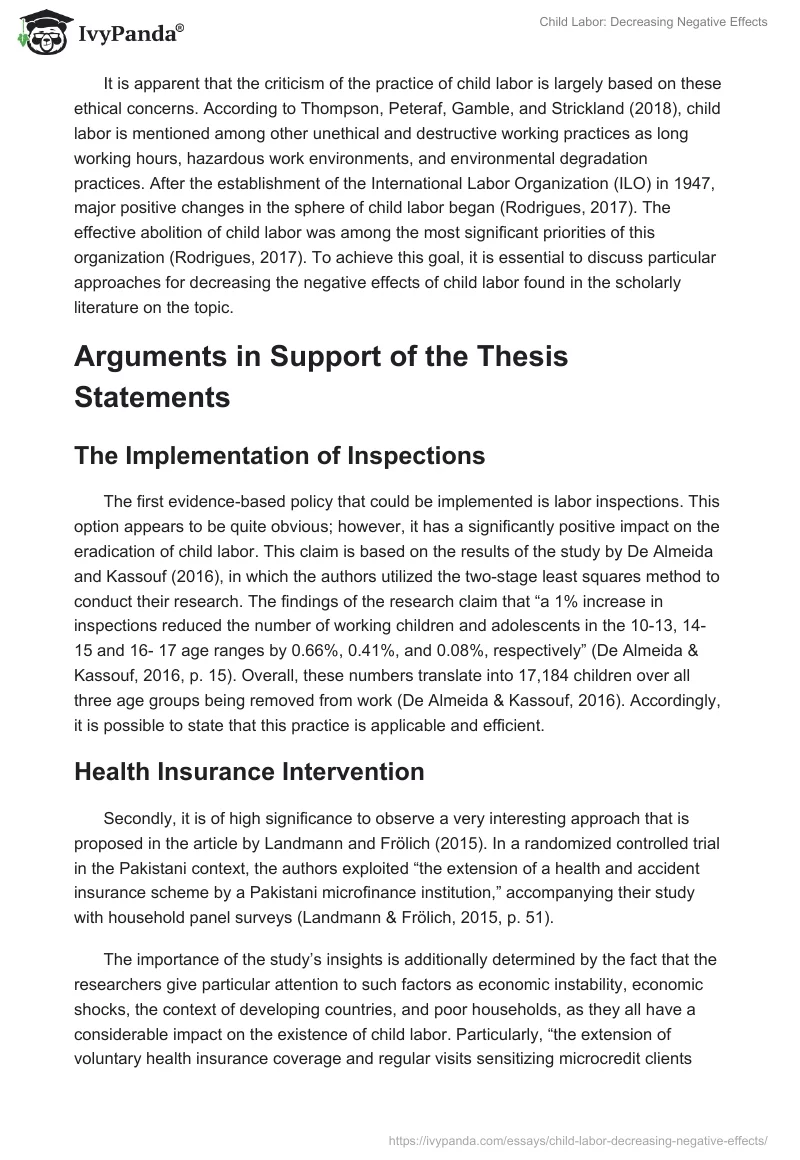During the past century, child labor has been increasingly viewed critically, despite it having been widely practiced throughout human history. As such, the civilized world has been increasingly attempting to eradicate it. Therefore, the question is raised: what improvements could be made in combating the problem of child labor across the world? Possible answers to this question include the development of a more effective inspection system, health insurance interventions, and a greater collective social effort, all of which can be seen to bring positive changes to the current existing issue. These thesis statements will serve as the framework for the development of the argument of this paper, and their evaluation will offer a comprehensive conclusion.
Development of the Argument
Overview of the Problem of Child Labor
Alongside other socio-economic issues, the phenomenon of child labor possesses a stronger ethical concern because the use of underage individuals for work directly contradicts modern standards of care for children. Even though efforts to eliminate child labor can be seen as largely successful, given this phenomenon is much less present in developed modern countries today, the practice of putting children to work can still be found in the majority of developing countries. As it is mentioned by Landmann and Frölich (2015), “child labor is a common consequence of economic shocks in developing countries” (p. 51). Therefore, the effects of the problem still persist.
It is also important to mention that child labor is a part of the larger concept of modern slavery, which is defined by Rodrigues (2017) in the following way. It constitutes
- forced labor,
- bonded labor,
- bad conditions of work,
- child labor, all of which are also generally characterized by the lack of liberty and dignity (p. 8).
It is apparent that the criticism of the practice of child labor is largely based on these ethical concerns. According to Thompson, Peteraf, Gamble, and Strickland (2018), child labor is mentioned among other unethical and destructive working practices as long working hours, hazardous work environments, and environmental degradation practices. After the establishment of the International Labor Organization (ILO) in 1947, major positive changes in the sphere of child labor began (Rodrigues, 2017). The effective abolition of child labor was among the most significant priorities of this organization (Rodrigues, 2017). To achieve this goal, it is essential to discuss particular approaches for decreasing the negative effects of child labor found in the scholarly literature on the topic.
Arguments in Support of the Thesis Statements
The Implementation of Inspections
The first evidence-based policy that could be implemented is labor inspections. This option appears to be quite obvious; however, it has a significantly positive impact on the eradication of child labor. This claim is based on the results of the study by De Almeida and Kassouf (2016), in which the authors utilized the two-stage least squares method to conduct their research. The findings of the research claim that “a 1% increase in inspections reduced the number of working children and adolescents in the 10-13, 14-15 and 16- 17 age ranges by 0.66%, 0.41%, and 0.08%, respectively” (De Almeida & Kassouf, 2016, p. 15). Overall, these numbers translate into 17,184 children over all three age groups being removed from work (De Almeida & Kassouf, 2016). Accordingly, it is possible to state that this practice is applicable and efficient.
Health Insurance Intervention
Secondly, it is of high significance to observe a very interesting approach that is proposed in the article by Landmann and Frölich (2015). In a randomized controlled trial in the Pakistani context, the authors exploited “the extension of a health and accident insurance scheme by a Pakistani microfinance institution,” accompanying their study with household panel surveys (Landmann & Frölich, 2015, p. 51).
The importance of the study’s insights is additionally determined by the fact that the researchers give particular attention to such factors as economic instability, economic shocks, the context of developing countries, and poor households, as they all have a considerable impact on the existence of child labor. Particularly, “the extension of voluntary health insurance coverage and regular visits sensitizing microcredit clients regarding claim procedures” are named as the most efficient policies (Landmann & Frölich, 2015, p. 59). In general, the findings of this article are considered robust enough to advise the implementation of this intervention in practice.
Participation of Civil Society
Another highly important policy that could be implemented in order to eradicate the negative effects of child labor, as well as the phenomenon under consideration as a whole, is the active participation of civil society. This could manifest itself in numerous forms, each being an effective instrument in combating child labor. For example, the importance of the press and mass media in contemporary modern society is highly evident, and thus social activists and journalists can have an immense impact on the current situation.
However, there is another more particular intervention mentioned in the study by Rodrigues (2017) that needs to be considered. This initiative is called the “dirty list” and, essentially, has the aim of creating a database of organizations that use child labor. Once it has been proven that companies are using underage workers in their manufacturing facilities, they can be exposed through this “dirty list” by means of TV or Internet information channels and would be expected to incur significant losses because their customers would not want to support such a company. The efficiency of this approach is evident, and it could be broadly implemented in various contexts and circumstances.
Other Perspectives on the Issue
In general, in our civilized world today, nobody would openly support the existence of child labor. However, there are other perspectives on this issue that are still subject to debate to a greater or lesser extent. For example, one of the most contradictory questions is the appropriate age at which to officially start work. Another perspective that is widely promoted states that child labor exists because parents with large families cannot provide for all of their family members, and thus it is normal that children should help support their family. While this assumption is true to some degree, it is still unacceptable for children to work in difficult conditions and degrading environments, and the additional issue of providing more comfortable workplaces in such circumstances is therefore raised.
Conclusion
In conclusion, while it is not pleasant to admit, child labor still exists in the modern world. However, the attitude of governments and societies is gradually changing toward the subject matter, as more and more people recognize that it is unethical to use children for work purposes. This paper provides a brief overview of the topic and proposes three approaches to tackle the issue, supported by the evidence from scholarly literature.
Additionally, alternative perspectives on the topic have also been discussed. Overall, this paper provides a critical investigation of a relevant, current subject matter that has to be improved. A more effective inspection system, health insurance interventions, and increased collective social effort are viewed as the most effective measures to be utilized in the fight against child labor.
References
De Almeida, R. B., & Kassouf, A. L. (2016). The effect of labor inspections on reducing child labor in Brazil. In Anais do XLIII Encontro Nacional de Economia[Proceedings of the 43rd Brazilian Economics Meeting] (No. 238). ANPEC- Associação Nacional dos Centros de Pós-Graduação em Economia [Brazilian Association of Graduate Programs in Economics].
Landmann, A., & Frölich, M. (2015). Can health insurance help prevent child labor? An impact evaluation from Pakistan. Journal of Health Economics, 39, 51-59.
Rodrigues, M. P. C. (2017). Compliance with labor standards: Measuring theeffectiveness of policies against child labor and modern slavery in Brazil. Web.
Thompson, A. A., Peteraf, M. A., Gamble, J. E., & Strickland, A. (2018). Crafting andexecuting strategy: The quest for competitive advantage: Concepts and cases (21st. Ed.). New York, NY: McGraw-Hill Education.


